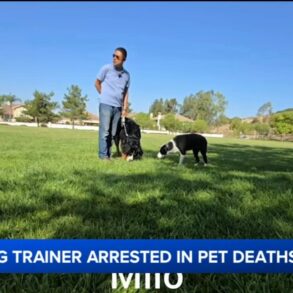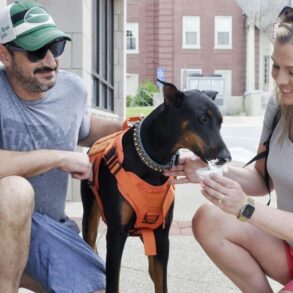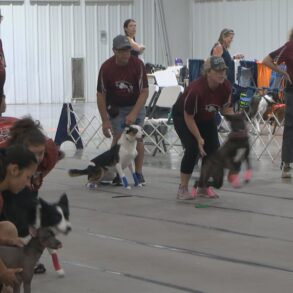
AMERICAN FORK — Abigail Allred and Mica Durant were on the verge of a crisis. Allred’s heart rate was rising during a graduation, and she needed to find a place to sit down before she passed out.
As her service dog, Maisie, was guiding her to a seat, her dog’s important work was interrupted by a well-meaning couple petting the dog.
The situation reflects many common experiences of those with service dogs. Service dogs on duty are busy protecting their owners, working in a team and providing necessary attention. When a lack of education about service dogs impacts the day-to-day life of owners, situations can get sticky, and owners can be seriously hurt.
‘She makes our lives so much fuller’
Allred and Durant, of American Fork, discussed the idea of getting a service dog for years. As she has post-traumatic stress disorder, postural orthostatic tachycardia syndrome and hyper-mobility issues, a service dog could be a great support for Allred. Authentic service dogs must be used by an individual with a disability and be task-trained, according to the ADA. Allred and Durant thought a service dog would be perfect for them.
In 2022, the couple decided to adopt Maisie and make her a part of their “team.” While many service dogs are trained by an outside facility, the pair decided to train Maisie themselves and prepare her for all the unique situations Allred may need her for.
“In order to increase accessibility for people with disabilities, they do allow for owner training,” Allred said.
Durant added, “Both routes are really, really hard. To be approved in a program, there is an extensive interview and background checks because they want to find a handler who will take care of these dogs.”
The training process was anything but easy. Starting with socialization and taking Maisie to dog-friendly places was the first step in training the dog. After she became comfortable with getting out in new environments, the couple trained her to perform behavior interruption, the action of intervening and disrupting problematic or specific behaviors in their handler.
For Allred, this included recognizing when her heart rate rose and when she might lose consciousness.
In addition to the training, the couple must constantly think about how to care for Maisie. Arriving at places early, finding places for Maisie to use the restroom and ensuring spaces are spacious enough to accommodate having a service dog are of utmost importance. Positive reinforcement guided the couple through the entire process.
The working and loving bond that Allred and Maisie have built has been instrumental in learning to navigate medical needs. Maisie can pick up things for Allred, alert her to a spell of unconsciousness coming on, help remove winter clothing or help guide her to a seat. Using sweat, the couple has been able to train Maisie to recognize when Allred’s heart rate has increased to an unhealthy or dangerous level.
“It’s a relationship,” Allred explained. “The dog is being trained, but then again, you have to know what to do to maintain that training.”
At any point, a service dog can “wash out,” meaning that they are not capable of performing the tasks needed to help their owner. This could include having specific fears, not enjoying working or getting easily distracted, according to After Gadget, a blog dedicated to all things service dog focused. Still, outside of her working role, Maisie has found a special place in Allred and Durant’s hearts.
“She makes our lives so much fuller,” Allred said.
“We love her so much. She is the other part of our life and our relationship,” Durrant said. “It really is us and our dog. We are a trio and a package deal.”
While Maisie loves to work, the couple has also seen how important it is to provide her with rest time and learn to read her body language.
“That’s their main form of communication, which is often why people’s patches or vests say, ‘Do not stare,'” Allred elaborated. “Eye contact for dogs is really confrontational. … These are a lot of the things we had to be well-versed in to make sure that we knew she was comfortable and happy working.”
Service dogs in public spaces
Throughout Maisie’s years of training and working as a service dog, the couple has run into numerous issues with non-service dogs being brought to public spaces. Not only can it be dangerous for Allred, but it can perpetuate negative stereotypes about service dogs. These stereotypes can potentially lead to business owners not accepting service dogs and further endangering their owners, at least in the couple’s case.
Additionally, the narrative of “distracting a service dog” can be harmful as well.
“Service dogs are still dogs,” Allred said. “They are not robots. There’s this misinformed narrative of trying to distract a service dog to test it.”
Ultimately, the couple hopes that more education around service dogs will be given. They believe that a crisis is not the time to educate the public about the role of and how to interact with service dogs.
What you should know
Under the Americans with Disabilities Act, service dogs have public access rights. They do not need to be vested or registered to be granted access. Most owners choose to put their dog in a vest in order to communicate with the public that the dog is working. Vests do not determine a service dog’s authenticity; their behavior does, according to New Life K9 Service Dogs.
To determine if a service dog is authentic, individuals may ask, “Is this a service dog?” and, “Is the dog task-trained?” Business owners and public spaces are not allowed to ask any clarifying questions about disabilities or the dog’s certification. However, if the service animal or dog is not being controlled by their handler at all times, a business owner may ask the animal to leave. Urinating, defecating or destroying public property is a clear indicator that an animal is not a service dog and can be asked to leave, according to the ADA National Network.
There is no official registration to verify if a service dog is legitimate. The only two requirements are having a disability and ensuring the animal is task trained to mitigate the disability’s effects, according to the ADA.
Service dogs can commonly be confused with emotional support animals. Emotional support animals are pets whose presence calms the owner. The animal does not have public access rights under the ADA and is not task-trained. Emotional support animals do have housing rights, according to the American Psychological Association. Psychiatric service dogs also differ from emotional support animals. These dogs are trained to either perform alert tasks (such as alerting an owner to an oncoming panic attack) or response tasks (such as performing deep pressure therapy for their handler).
Nonofficial service dogs being taken out in public places can lead to dangerous consequences for owners and a dog potentially getting washed out. That event can be “ruinous” for individuals living a life with a disability, according to Durant. Service dogs must be leashed unless being leashed could interfere with a specific task for a disability or the handler cannot use a leash, according to the ADA.
When interacting with a service dog, the best thing to do is ignore the dog entirely. This includes not petting, making eye contact with or getting too close to a service dog. Pointing out a service dog to a child or encouraging children to pet the dog is also harmful. Distracting a service dog while on the job or allowing your dog to distract the dog on duty is a class B misdemeanor, according to Utah law. Additionally, keep in mind that service dogs need space in order to perform their job. Passing them in the grocery store or getting too close in public spaces could lead to the dog being injured or stepped on, according to Retrieving Freedom Inc.
Service dogs cannot be trained to protect or defend their owners. Biting, attacking or loudly barking at other individuals is not a part of a service dog’s purpose. Similarly, in the event of an emergency, service dogs are not supposed to go find help. They should instead stay with their owner and/or bark to alert, according to Durant, Allred and Medical Service Dogs.
For more information or clarification on service dog rights, responsibilities and behaviors, visit the ADA website.
The Key Takeaways for this article were generated with the assistance of large language models and reviewed by our editorial team. The article, itself, is solely human-written.
This post was originally published on this site be sure to check out more of their content.













































